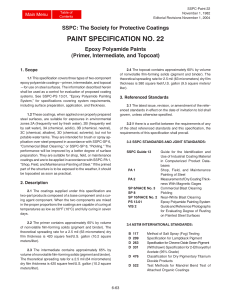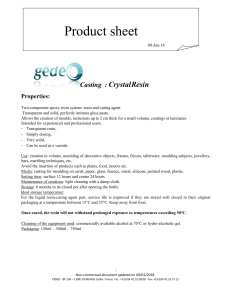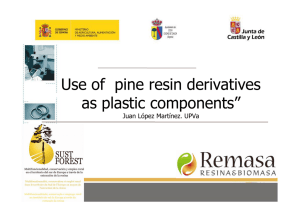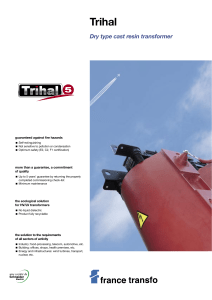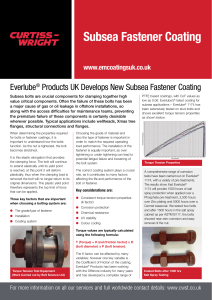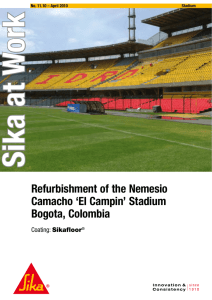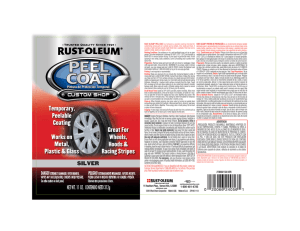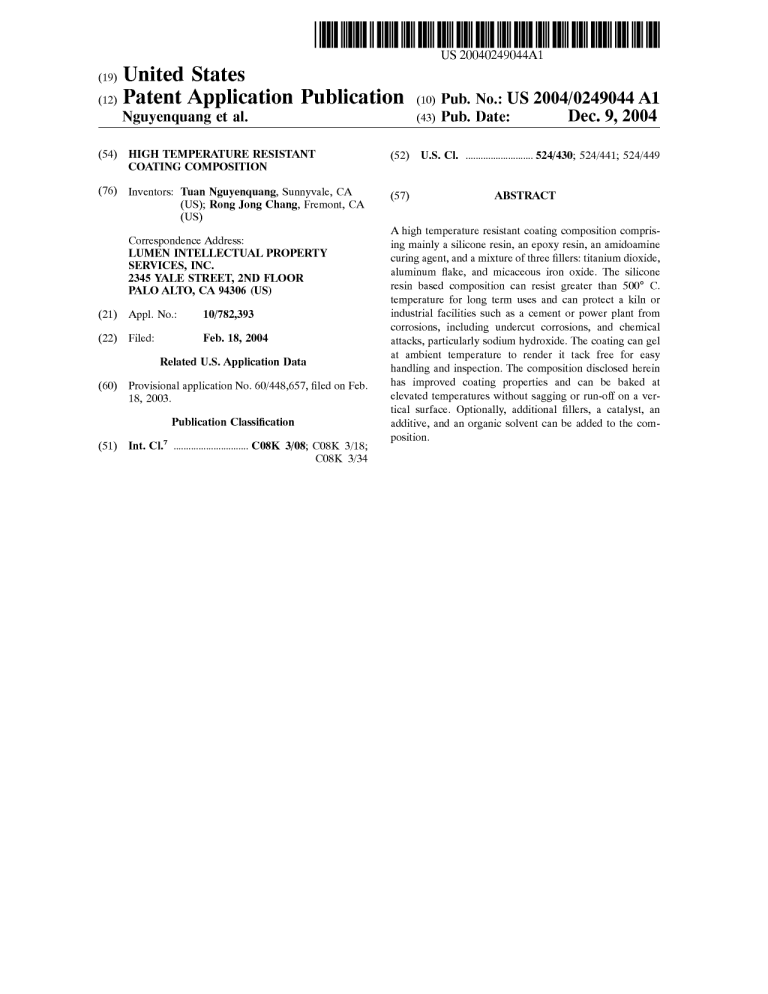
US 20040249044A1 (19) United States (12) Patent Application Publication (10) Pub. No.: US 2004/0249044 A1 Nguyenouang et al. (43) Pub. Date: Dec. 9, 2004 (54) HIGH TEMPERATURE RESISTANT (52) U.S. Cl. ........................... 524/430; 524/441; 524/449 Sunny Vale, CA (76) InVentors: Tuan Nguyenquang, Sunnyvale, (57) COATING COMPOSITION (US); Rong Jong Chang, Fremont, CA (US) Correspondence Address: EENSTELECTUAL PROPERTY ABSTRACT A high temperature resistant coating composition compris ing mainly a Silicone resin, an epoxy resin, an amidoamine curing agent, and a mixture of three fillers: titanium dioxide, 2345 YALESTREET 2ND FLOOR aluminum flake, and micaceous iron oxide. The Silicone PALO ALTO, CA 54306 (US) resin based composition can resist greater than 500 C. temperature for long term uses and can protect a kiln or industrial facilities Such as a cement or power plant from corrosions, including undercut corrosions, and chemical attacks, particularly Sodium hydroxide. The coating can gel (21) Appl. No.: 10/782,393 (22) Filed: Feb. 18, 2004 O O Related U.S. Application Data (60) Provisional application No. 60/448,657, filed on Feb. 18, 2003. Publication Classification (51) Int. Cl. .............................. C08K 3/08, COSK 3/18; CO8K 3/34 at ambient temperature to render it tack free for easy handling and inspection. The composition disclosed herein has improved coating properties and can be baked at elevated temperatures without Sagging or run-off on a ver tical Surface. Optionally, additional fillers, a catalyst, an additive, and an organic Solvent can be added to the com Osition. US 2004/0249044 A1 HIGH TEMPERATURE RESISTANT COATING COMPOSITION CROSS-REFERENCE TO RELATED APPLICATIONS 0001. This application claims priority from a provisional patent application No. 60/448,657, filed Feb. 18, 2003, the content of which is incorporated herein by reference. FIELD OF THE INVENTION 0002 The invention generally relates to a high tempera ture resistant coating composition. More particularly, it relates to a composition comprising mainly a mixture of a Silicone resin (A), an epoxy resin (B), an amine curing agent (C), and a combination of fillers (D), which can be cured at ambient temperature to render it a tack free Surface. After Subsequent heat cure, the coating exhibits good film prop erties, high temperature resistance and undercut corrosion resistance. DESCRIPTION OF THE BACKGROUND ART 0.003 Over the past 50 years, silicone resins have increas ingly been used in the high temperature coatings. Listed below are Several Overview papers that provide a good introduction of the technology and an excellent Summary of the background arts. The respective content of these papers is incorporated herein by reference. 0004) 1. Clive H. Hare, “Silicone Resins,” JPCL (Jour nal of Protective Coatings and Linings), January 1995, pp. 79-103. 0005 2. William A. Finzel, “Properties of High Tem perature Silicone Coatings, JPCL, August 1987, pp. 38-43. 0006 3. William A. Finzel, “Silicone Coatings, Generic Coating Types,” JPCL, August 1995, pp. 93-106. 0007 AS described in the aforementioned references, the high temperature resistance of Silicone resins has been attributed to its Silicon-OXygen backbone in contrast with the carbon-carbon backbone for most organic polymers. A coat ing based on 100% silicone resin can resist up to 371 C. To achieve an even higher temperature performance, a platelet type of inorganic or metallic filler Such as mica or aluminum flake is added to form a thermal reflective layer, and Some filled silicone resin coatings can resist as high as 638 C. (1200°F). 0008 However, silicone resin based coatings for high temperature applications still Suffer from Several shortcom ings. First, Silicone resin is Susceptible to chemical attack, particularly by Sodium hydroxide, and if aluminum flake is used to raise the temperature performance, it reduces acid resistance of the coating. Second, a Silicone resin based coating requires high temperature baking above 200 C. to achieve the desired heat resistance properties. The coating can Sag and run off during the heating process and thus leads to uneven or defective coating. Third, the Silicone resin based coating is brittle and Susceptible to cracking and lifting especially under thermal StreSS. This problem is particularly Severe if the coating has poor adhesion or when its thickness is greater than three mils. Fourth, due to its Dec. 9, 2004 inorganic nature, the coating properties Such as gloSS, impact resistance, toughness, or abrasion resistance are poor com pared with most organic based coatings. Last, they have poor resistance to undercut corrosion, i.e., when there is pit corrosion developed due to imperfection in the coating, it quickly propagates underneath the coating. 0009. To address some of the aforementioned shortcom ings, one can modify Silicone resin with organic compo nents. The modification can be achieved by Simply blending an organic resin with the Silicone resins or by direct Substi tution of an reactive organic functionality onto the Silicone resins, as described by Keijman, “The Use of Novel Silox ane Hybrid Polymers in Protective Coatings.” PCE (Protec tive Coatings Europe), July 1996, pp. 26-32. Examples of chemically substituted silicone resins are Silikoftal(R) ED and SilikofalEEW, both of which are epoxy functionalized Silicone resins Supplied by Tego Chemie. The epoxy func tionality allows ambient curing when a Suitable curing agent Such as an amine is added to the composition to pre-cure the coating and thus prevents the coating from Sagging or run-off during the Subsequent baking at elevated tempera tureS. 0010) By adding the organic content, the film forming properties and crack resistance are also improved. However, the increasing of organic content either by blending or functionalization normally compromises the heating resis tance. The heat resistance of most organic modified Silicone resin coatings is limited to 232 C.-371. C., as noted in the Reference 2 cited above. 0011 Thus, the challenge for the application of the sili cone resin based coatings has been how to improve the film forming properties without Sacrificing heat resistance. Muis disclosed in U.S. Pat. No. 4,190,686 a composition com prising a ceramic glaze material, a thermosetting phenolic resin, an organic paint resin Such as epoxy, polyester or acrylic and a Silicone resin as leveling agent. The coating was either for protection Steel from corrosion and chemical attack or for protection of wood from fire. There was no mention of heat resistance; however, as it would have been apparent to any perSon Skilled in the art, Muis's composition is unlikely to be Suitable for a long-term exposure at temperatures greater than 200 C. 0012 Arai disclosed in U.S. Pat. No. 4,374,754 a self cleaning coating composition containing a Silicone resin, an organic Solvent, an oxidation catalyst Such as manganese oxide and/or platinum or palladium. The composition was designed to catalytically oxidize and remove fats and oils on interior Surfaces of an oven, and it was claimed to resist temperature up to 600 C. 0013 Matsumoto et al. disclosed in U.S. Pat. No.'s 4,657,963 and 4,746,568 compositions consisting of a modi fied Silicone resin, an aluminum chelate compound Such as ethyl acetate aluminum diisopropylate, an organic resin, and a mixture of pulverized inorganic materials for use in coating exhaust pipes of motorcars. The compositions showed good film forming properties and corrosion protec tion without compromising heat resistance. 0014 Eklund et al. disclosed in U.S. Pat. No. 6,180,726 a high temperature resistant powder coating composition comprising a resin containing functional hydroxyl groups, a polyfunctional epoxy resin, and an anhydride compound. The composition was claimed to withstand high temperature up to 300° C. US 2004/0249044 A1 Dec. 9, 2004 0.015 The prior patents cited above addressed some but not all of the aforementioned shortcomings of Silicone resin based coatings. Therefore, there remains a need in the art for a high temperature resistant coating composition that over comes all drawbacks of the prior arts. SUMMARY OF THE INVENTION 0016. Accordingly, it is the primary object of the present invention to provide an improved Silicone resin based coat ing which can resist greater than 500 C. temperature for long term uses. 0.017. It is another object of the present invention to provide an improved Silicone resin based coating that can gel at ambient temperature to render it tack free for easy handling and inspection. 0.018. It is a further object of the present invention to provide an improved Silicone resin based coating that can be baked at elevated temperatures without Sagging or run-off on a vertical Surface. 0019. It is another object of the present invention to provide a Silicone resin based coating that has improved coating properties. 0020. It is still another object of the present invention to provide a Silicone resin based coating with improved chemi cal resistance, particularly to Sodium hydroxide. 0021. It is yet another object of the present invention to provide a Silicone resin based coating with improved resis tance to undercut corrosion. 0022. These objectives are achieved in a novel and inven tive high temperature resistant coating composition com prising mainly a Silicone resin, an epoxy resin, an amidoam ine curing agent, and a mixture of three fillers: titanium dioxide, aluminum flake, and micaceous iron oxide that met all objects desired. The composition is particularly useful for protecting a kiln or baghouse in industrial facilities, Such as a cement or power plant, from corrosion and chemical attack. DESCRIPTION OF THE INVENTION 0023. According to the present invention, the high tem perature resistant coating composition consists of the fol lowing ingredients and their mass percentages. The total mass percentage of all ingredients must be 100%. Ingredient A. Silicone resin (without solvent) B C Epoxy resin Epoxy curing agent D Fillers (1) Aluminum flake (2) Titanium dioxide (3) Micaceous iron oxide (4) Others (optional) B F G Catalyst (optional) Additive (optional) Solvent (optional) Total Mass % 10-17.5 3-15 6-30 1-10 35-45 7-2O 0-10 O-1 O-5 O-7 1OOOO 0024. The Component A, silicone resins, can be a straight or modified resin. In actual production, Silicone resin may contain a certain amount of Solvent, e.g., 20-35 mass parts of silicone resin with 50% in Xylene. As one skilled in the art will appreciate, any amount of Solvent may be used in actual production and is not limited to a 50% solution. The Straight Silicone resin has a general formula of: (RO)-Si----O-(Si-O),-(Si-O),---Si-(OR), 0025 where R=either H, or CH, or CH, 0026 R=an alkyl, acyclic, or aryl, preferably CH or Phenyl (-CH3), 0027 R=an alkyl, acyclic, or aryl, preferably CH or Phenyl (-CH3), 0028 R=R or RzR, and 0029) m=1-3, preferably 2, most preferably 3. 0030 The combination of X and y determines the molecu lar weight of the resin, and either X or y can be from 1 up to Several thousands. The ratio or y/x determines the croSS linking density of the final bake coating, and it can be from 20 for a high density network to 0.05 for a low density network. Preferably (x+y) and y/x of the resin are low enough So that the resin is a liquid by itself, or can be dissolved in an organic Solvent to form a liquid Solution So that the final coating can be toweled, brushed, or Sprayed. 0031. In the modified silicone resin, from 1% to 30% of R is replaced with a reactive functional group Such as epoxy, amine, Vinyl, hydride, acrylic, anhydride, carboxylic, etc. 0032. The silicone resins useful for the present invention can be a mixture of many Straight Silicon resins, or a mixture of straight silicone resins with up to 49% of modified Silicone resins. 0033. The Component B, epoxy resin, can be any bisphe nol Adiglycidyl ether, bisphenol F diglycidyl ether, phenolic epoxy, phenol novolac epoxy, creSol novolac epoxy, tris(hy droxylphenyl) methane triglycidylether, triglycidyl p-ami nophenol, tetraglycidyl amine of methylenedianiline, 1,3,5- tris(2,3-epoxypropyl)-1,3,5-perhydrotriazine-2,4,6-trione (triglycidyl isocyanurate), polyglycidylether of poly(4-hy droxylstyrene), etc. It is preferable that B-1 be in a liquid form. If it is in Solid form, a suitable solvent may be added to prepare a liquid Solution. It is also understood that B-1 can be a mixture of various epoxy resins mentioned above. It is preferable that the epoxy resin is a novolac epoxy due to its low Viscosity and good chemical resistance. 0034. The Component C is an amine curing agent or a mixture of amine curing agents for the Component B (epoxy resin). The curing agents include aliphatic amines, ami doamines, and cycloaliphatic amines. It is preferable to use amidoamines Since they provide better adhesion to metal and also adequate pot life for the formulations. It is prefer able that a Stoichiometry amount of curing agent be used to US 2004/0249044 A1 react with the epoxy resin. However, a deviation of 15% from the Stoichiometry amount will not significantly affect the coating properties of the present invention. 0035) The Component D is a mixture of fillers of mainly three fillers: aluminum flake, titanium dioxide, and mica ceous oxide. Aluminum flake can be leafing or non-leafing type, preferably a non-leafing type. It can be in Solid form or pre-dispersed in a paste form. Titanium dioxide can be anatase or rutile type, preferably rutile type. Micaceous iron oxide refers to a crystalline form of iron oxide which naturally occurring in pallet form, which is very different from the more familiar red, yellow, and brown form of iron oxides. Optionally, other fillerS Such as mica, glass flakes, etc. can be added in Small amount without significantly deteriorate the coating properties of the present invention. 0.036 The Component E is a catalyst optionally added to promote cross-linking reaction of Silicone resin during high temperature bake. Most metallic organic Salts. Such as Zir conium octoate, cobalt octoate, Zinc octoate, iron Octoate, StannouS Octoate, or a commercial catalyst, Such as K-Kat 348 Supplied by King Industries, can be used. There are many known catalysts and any perSon Skilled in the art will have no problem choosing Such a catalyst. 0037. The Component F is additional additive(s) such as Wetting agent, dispersing agent, deflocculating agent, thiXO tropic agent, defoaming agent, leveling agent, colorant, coupling agent, etc., that can be added to help dispersing of fillers, preventing filler settling, and improving film forming properties or appearance. 0.038. The Component G is an organic solvent, optionally added to reduce Viscosity of the mixture to facilitate coating application Such as air Spray or airleSS spray. The amount of Solvent should be kept at a minimum, e.g., below 3.5 pounds per gallon of coating, preferably below 2.8 pounds per gallon, and most preferably below 1.8 pounds per gallon to reduce environmental pollution. Organic Solvent Selected must be compatible with Silicone and epoxy resins. Toluene or Xylene is often used with Silicone resins. 0.039 To prepare the coating, a laboratory high speed disperser is used. Weigh titanium dioxide in a one-liter Stainless container, and add Silicone resin and epoxy resin. Let the mixture sit for 30 minutes. This will allow resins to soak into titanium dioxide. Mix the mixture with the high Speed disperser at 4000 rpm and move the mixing blade up and down if necessary until the mixture is well dispersed. The mixture should achieve a reading of 7 or higher on the Hegman dispersion gauge. This process should take about 15-30 minutes. Add micaceous iron oxide and continue to mix at 4000 rpm for another 15-20 minutes until the mixture achieve a reading of 6 or higher on the Hegman gauge. Reduce the speed to 400 rpm and gently blend aluminum flake to the mixture. Close the lid of the container and let the whole mixture soak overnight (about 12-16 hours). Next, stir the mixture at 800 rpm for 15 minutes. Add solvent to obtain the Part A of the composition. Keep amine curing agent (Component C) separate as Part B of the composition. Part A and Part B are to be mixed just prior to coating applica tion. 0040. The following example shows a high temperature resistant coating composition prepared according to an embodiment of the present invention. EXAMPLE 1. Dec. 9, 2004 Ingredient Description A Silikophen P50/X Silicone resin (50% in xylene) (Tego Chemie) B Epalloy 8230 Novolac Epoxy (CVC Specialty Chemicals) C Ancamide 2353 Polyamidoamine curing agent Mass % 25.96 6.49 1341 (Air Products) D Fillers (1) DF-L 520 AR (Silberline) (2) Tiona RCL-9 (Millenium) (3) Nubifer EF G (Nubiola) Xylene Aluminum flake 5.19 Titanium dioxide 42.18 Micaceous iron Oxide 13.32 Solvent Total 3.37 1OOOO 0041. The high temperature resistant coating composition So prepared, applied in a 5-mil Single layer on a Steel panel (Q-Panel), became tack-free within 12 hours at room tem perature. The coated panel was then cured at 250 C. in a Vertical position for one hour and no Sagging or run-off was observed. After baking, the coated panel was quickly brought out of the oven and cooled down to ambient temperature. No delamination was observed during the thermal contraction. The baked coating showed high gloSS and exhibited good Scratch resistance. 0042. The chemical resistance was tested by ASTM D471 by immersing a coating film in each of the test chemical for one week, and % weight gain was measured. It showed the weight gain in water, 36% sulfuric acid, 54% phosphoric acid, and 50% sodium hydroxide was 0.8%, 1.1%, 1.2%, and 2.5%, respectively. 0043. The baked coatings films were then subjected to long term heat aging at 250° C., 325 C., and 550° C. The baked films were taken out of the heating aging Ovens weekly to Simulate thermal cycling. The coatings resisted 325 C. and 550° C. up to three months without significant change in film properties and showed no cracking due to thermal cycling. 0044 Abaked film coated on a sand-blasted Q-Panel was also Scribed and Subjected to outdoor exposure with periodic Spray of Sodium chloride Solution for two months according to ASTM D6675. The coating had very good resistance to undercut corrosion, having less than 0.5 mm ingress of corrosion from the scribed line in one month. The adhesion of the coating remained good after the outdoor aging. 004.5 This working example demonstrated that the com position prepared according to the present invention is Suitable for use in many applications as a high temperature resistant coating to protect Steel from corrosion and chemi cal attack. COMPARATIVE EXAMPLE 1. 0046) Instead of using a physical blend of epoxy resin with Straight Silicone resin, this comparative example was formulated with an epoxy modified Silicone resin, in which the epoxy functional group was chemically attached to the Silicone resin. US 2004/0249044 A1 A. Dec. 9, 2004 Ingredient Description Silikoftal ED Epoxy modified silocone resin Mass % 34.92 (Tego Chemie) C Ancamine 2089M Modified Polyamine curing agent D Filers (1) Tiona RCL-9 Rutile titanium oxide (Millenium) (2) Mica 20E Muscovite mica 5.82 45.04 14.32 (Fibertec) Total 1OO.OO 0047 A coating prepared according to the above formu lation was applied onto a Q-Panel the Same way as described in Example 1. The coating gelled and became tack free in 12 hours, and it was then baked in a vertical position at 250 C. coatings were taken out of the heat aging ovens daily in the first week and weekly afterwards to simulate thermal cycling. The coatings resisted 250 C. aging for 3 months without cracking or delaminating. However, the baked films appear powdery and the thickneSS should be kept below 2 mils to avoid cracking. At 325 C. and 550 C., the coatings delaminated and cracked as Soon as they were taken out of the Ovens after one day. This demonstrated that the coating based on the blend of silicone resins is not suitable for applications of temperature higher than 250 C. and there fore is Substantially leSS Versatile and useful than the present invention as shown in Example 1. COMPARATIVE EXAMPLE 3 (SP7A1) 0052 This comparative example is to demonstrate the effect of the filler package. for one hour. 0.048. The baked coating films were then subjected to long term heat aging at 250° C., 325 C., and 550° C. The baked films were taken out of the heating aging ovens weekly to Simulate thermal cycling. The coatings resisted 250 C. aging for one week without cracking and delami nating, but at 325 C. and 550° C. they became powdery and eventually mud-cracked in three days. This demonstrated that, unlike the present invention as shown in Example 1, the coating based on the epoxy modified Silicone resin is not suitable for applications of temperature higher than 250 C. Ingredient A. B C D 0049. A commercial silicone resin based coating was also Selected for comparison with the present invention. The following formulation was recommended by GE Silicones in its technical data sheet, which is included herein by refer CCC. Mass % Silikophen P50/X Phenyl methyl polysiloxane resin (50% in xylene) Epalloy 8230 (CVC Specialty Chemicals) Ancamide 2353 (Air Products) 26.95 (Tego Chemie) Phenol Novolac epoxy 6.74 Modified polyamide 3.61 curing agent Fillers (1) Tiona RCL-9 Rutile titanium dioxide (Millenium) (2) Mica 20E G COMPARATIVE EXAMPLE 2 Description (Fibertec) Xylene 44.99 Muscovite mica 14.21 Solvent Total 3.50 1OO.OO 0053 A coating prepared according to the above formu lation was applied onto a Q-Panel the Same way as described in Example 1. The coating gelled and became tack free in 12 hours. It was then baked at 250 C. for one hour. Ingredient A. (1)Triplus 179 Description Methylsilsesquioxane Mass % 22.09 resin (2)Triplus 178 D 18.07 Titanium oxide 45.38 Muscovite mica 14.46 Fillers (1) Tiona RCL-9 (Millenium) (2) Mica 20E E Polydimethylsiloxane (GE Silicones) (Fibertec) K-Kat 348 Catalyst O.OO)4 (King Industries) Total 1OO.OO 0050. A coating prepared according to the above formu lation was applied onto a Q-Panel the Same way as described in Example 1. The coating did not cure at ambient tempera ture and it Sagged when applied on a vertical Surface. Thus, the Q-Panel was placed in a horizontal position and baked at 250 C. for one hour. The baked coating had a slightly powdery Surface and the coating properties were not as good as that of Example 1. 0051. The baked coating films were then subjected to long term heat aging at 250° C., 325 C., and 550° C. The 0054 The baked films were then subjected to long term heat aging at 250 C., 325 C., and 550° C. The coatings were taken out of the heating aging ovens daily in the first week and weekly afterwards to Simulate thermal cycling. The coatings resisted 250 C. and 325 C. aging for three months without cracking and delaminating. However, the baked films appear powdery and the thickness should be kept below 2 mils to avoid cracking. At 550 C., the coatings delaminated and cracked as Soon as they were taken out of the Ovens after one day. This demonstrated that the coating based on the blend of silicone resins is not suitable for applications of temperature higher than 250 C. and there fore is Substantially leSS Versatile and useful than the present invention as shown in Example 1. COMPARATIVE EXAMPLE 4 0055. This comparative example offers yet another dem onstration of the filler effect. Ingredient A. Description Silikophen P50/X Phenyl methyl polysiloxane resin (50% in xylene) Mass % 28.OO (Tego Chemie) US 2004/0249044 A1 Dec. 9, 2004 C) an epoxy curing agent having a mass percentage of approximately 6 to 30; -continued B C D Ingredient Description Epalloy 8230 Phenol Novolac epoxy (CVC Specialty Chemicals) Ancamide 2353 (Air Products) 7.00 Modified polyamide 3.76 curing agent (Fibertec) (3) REF-160 (NGF Canada) Xylene (2) titanium dioxide having a mass percentage of approximately 35 to 45; and Filers (2) Mica 20E D) a filler package comprising: (1) aluminum flake having a mass percentage of approximately 1 to 10; (1) Tiona RCL-9 Rutile titanium dioxide (Millenium) G Mass % 37.40 (3) micaceous iron oxide having a mass percentage of approximately 7 to 20; Muscovite mica 11.81 Microglas glass flake 8.40 E) an optional catalyst having a mass percentage of Solvent 3.64 sis and condensation reactions of Said Silicone resin; Total 1OO.OO 0056. A coating prepared according to the above formu lation was applied onto a Q-Panel the Same way as described in Example 1. The coating gelled and became tack free in 12 hours, and it was then baked at 250 C. for one hour. When the baked coating was subjected to 50% sodium hydroxide, it was totally dissolved in a few days. 0057 The baked films were then subjected to long-term heat aging at 250 C., 325 C., and 550 C. The coatings were taken out of the heating aging ovens daily in the first week and weekly afterwards to Simulate thermal cycling. approximately 0 to 1, Said catalyst promoting hydroly F) an optional additive having a mass percentage of approximately 0 to 5, Said additive facilitating mixing or adjusting rheology of Said coating composition; and G) an optional organic Solvent having a mass percentage of approximately 0 to 7. 2. The coating composition according to claim 1, Said Silicone resin having a formula of: (RO)-Si----O-(Si-O-(Si-O),---Si-(OR), Rs The coatings resisted 250 C. and 325 C. aging for three months without cracking and delaminating. However, the baked films appear powdery and the thickness should be kept below 2 mils to avoid cracking. At 550 C., the coatings delaminated and cracked as Soon as they were taken out of the Ovens after one day. This demonstrated that the coating based on the blend of silicone resins is not suitable for applications of temperature higher than 325 C. and there fore is Substantially leSS Versatile and useful than the present invention as shown in Example 1. 0.058 Although the present invention and its advantages have been described in detail, it should be understood that the present invention is not limited to or defined by what is shown or discussed herein. The tables, description and discussion herein illustrate technologies related to the inven tion, show examples of the invention and provide examples of using the invention. Known methods, procedures, SyS tems, elements, or components may be discussed without giving details, So to avoid obscuring the principles of the invention. One skilled in the art will realize that implemen tations of the present invention could be made without departing from the principles, Spirit, or legal Scope of the present invention. Accordingly, the Scope of the present invention should be determined by the following claims and their legal equivalents. We claim: 1. A high temperature resistant coating composition hav ing a total mass percentage of 100, Said coating composition comprising: A) a Silicone resin having a mass percentage of approxi mately 10 to 17.5; B) an epoxy resin having a mass percentage of approxi mately 3 to 15; O-R where R is Selected from the group consisting of H, CH, and CH5, R is Selected from the group consisting of alkyl, acyclic, aryl, CH, and Phenyl (-CH3); R is Selected from the group consisting of alkyl, acyclic, aryl, CH, and Phenyl (-CH3); m is an integer Selected from the group consisting of 1, 2, and 3; X and y are integers where x-y is from 2 to 6000 and y/x is from 0.05 to 20; wherein R=R or RazR. 3. The coating composition according to claim 1, wherein Said epoxy resin is Selected from the group consisting of bisphenol A diglycidyl ether, bisphenol F diglycidyl ether, phenol novolac epoxy, cresol novolac epoxy, tris(hydroxy lphenyl) methane triglycidylether, triglycidyl p-aminophe nol, tetraglycidyl amine of methylenedianiline, 1,3,5-tris(2, 3-epoxypropyl)-1,3,5-perhydrotriazine-2,4,6-trione (triglycidyl isocyanurate), and polyglycidylether of poly(4hydroxylstyrene). 4. The coating composition according to claim 1, wherein Said epoxy curing agent is Selected from the group consist ing of aliphatic amines, amidoamines, and cycloaliphatic amines. 5. The coating composition according to claim 1, wherein Said aluminum flake is Selected from the group consisting of leafing aluminum flakes or non-leafing aluminum flakes. 6. The coating composition according to claim 1, wherein Said titanium dioxide is Selected from the group consisting of rutile titanium dioxides and anatase titanium dioxides. US 2004/0249044 A1 7. The coating composition according to claim 1, wherein Said filler package optionally contains other fillers including mica, glass flakes, or a combination thereof. 8. The coating composition according to claim 1, wherein Said catalyst is Selected from the group consisting of Zirco nium Octoate, cobalt octoate, Zinc octoate, iron Octoate, StannouS Octoate, or a commercial off-the-shelf catalyst. 9. The coating composition according to claim 1, wherein Said additive is Selected from the group consisting of a Wetting agent, a dispersing agent, a deflocculating agent, a thixotropic agent, a defoaming agent, a leveling agent, colorant, a coupling agent, and a combination thereof. 10. The coating composition according to claim 1, wherein Said organic Solvent dissolves Said Silicone resin and Said epoxy resin Simultaneously to form a uniform mixture. Dec. 9, 2004 11. The coating composition according to claim 10, wherein Said organic Solvent is Selected from the group consisting of toluene and Xylene. 12. The coating composition according to claim 1, wherein Said coating composition is capable of resisting chemical attacks including Sodium hydroxide and of resist ing high temperature of 500 C. or more.

